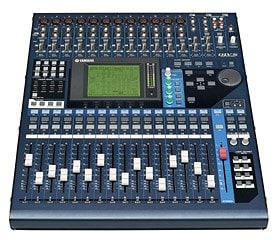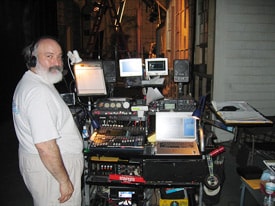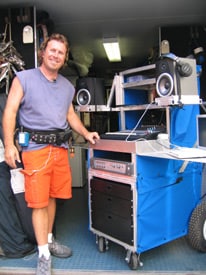Digital Goes on Location
 01V96 |
Over the years, Ulano has seen major changes in his industry: the decline of the studio system, the move from staffed to freelance operators, and the shift from analog to digital audio.
"Sound mixers work with a palate of tools and techniques built around supporting a scene and the film through the vision of the director," he explains. "You have to use the best tools that won't interfere with the creative side, and with that in mind, digital audio has allowed us to integrate a lot of diverse chunks of life into one unified whole. It's been a great consolidator. Production sound shifted from analog to digital to accommodate postproduction facilities using DAWs and non-linear editing systems."

Mark Ulano with his main field sound cart and primary 01V96. |
Among Ulano's favorite digital tools are his recent acquisitions, a pair of Yamaha 01V96 mixers. "It's not often that I get excited about gear, but the 01V96 has literally solved a lot of issues in one fell swoop," he notes. "It's enormously flexible. We're dealing with more complexity, multi tracking and communication issues in the field who should hear what version of what mix, the number of available auxes, etc. Digital will meet any challenge, and makes things immediately possible. Bringing the 01V96 onboard has allowed me to centralize all my issues in terms of recording devices and multiple media."
Ulano's on-set staff includes a boom operator Tom Hartig, and utility sound tech Adam Blantz. "Our responsibility is to record the elements that support the visual the principals, actors, some effects as they occur live in front of the camera, and react to the blocking and the frame," he says. That includes mic placement, interaction with the talent, the director and the cinematographer during the shot-by-shot process of principal photography.
"A typical day goes like this," he explains. "We arrive, and the director will be on the set with the talent, doing a physical blocking of a scene. They'll then show it to all the department heads sound, cameras, lighting, props everyone who is there to make it happen. The talent goes to makeup and wardrobe while the film crew sets up the shot, based on the blocking. The talent returns, everyone does final touches and we shoot, then do it again for the next shots. Recorded dialogue isn't just a scratch for what will be dubbed in later. That's a common myth. The goal is to preserve performances, not just capture references.
"My music background helps on so many levels, as I'm literally mixing on the set, not just getting sounds," he continues. "You're aiming for a mix that's coherent, and have to think like the actors who are dealing with segmented action. All choices levels, dynamics, mics selected, etc. must make the process seamless, even when recording in hostile environments."
 Utility sound tech Adam Blantz with the ProTools rig. |
"[Robert] Altman doesn't care about the naturalism of the sound, while Quentin [Tarantino] will go to great length to capture original performances. James [Cameron] will run ADR, or loops, on every single line before he's done his mix, and then he'll work backwards to use the tracks he originally shot, and make a word-by-word assessment in the postproduction stage. Others will only redo or correct things after the picture has been cut."
One 01V96 is rack mounted, with the second set aside as a spare. "Since the price point allowed us to have a second 01V96, it actually provided more security than any analog mixer," Ulano says. "I'm based entirely in the digital domain, and have owned three digital hard drive recorders (DiVA 489, Fostex PD6 and Aaton Cantar-X). We send AES/EBU and take AES/EBU returns to the board. We use 48kHz resolution for dialogue, but with music, we'll kick it up to 96k, and the 01V96 does that fluidly and intuitively. It makes no sense to go backwards by beginning with all this digital hardware and feed it with an analog source."
"I have 40 inputs with the ADAT, yet it's so compact that you never have a sense of any of that," he adds. "We use an Alesis AI3 via TOSLink eight-in/eight-out A-to-D box in tandem with 01V96, which offers complete isolation. We send different output feeds to the video press kit guys, the video assistants and the person who's recording the director's reference. The system uses optical fiber, which eliminates grounding problems."
Ulano also carries a ProSine inverter with an aircraft-style glassmat deepcycle battery, which can run independently for almost two days on pure sine wave AC. "No more cables and fields," he says. "When you're shooting in China, Japan and Mexico, like we did for almost a year for Kill Bill, power is not always a certainty."
The major factor in switching to the 01V96 was recallability. "If there's a specific actor who has certain voice characteristics, or a piece of challenging wardrobe that requires a certain EQ, I can store that in a library, and even name it for that actor, scene, wardrobe etc. We'll also save configurations. It's just an enormous aid, because time is money, and shooting can't be held up because you're dialing in settings. Sometimes we'll double track a boom mix and radio mic mix, and sometimes music is recorded live. A recent project (HBO Special Projects' Empire Falls starring Paul Newman, Ed Harris and others) had an eight-track ProTools situation, so we had the second 01V96 running the DigiDesign system for a simple 8-track live record and subsequent playback with overdub on camera."
"Generally, we don't get too deep into the onboard effects, except for the gates and limiters. We're conservative with EQ-it's for matching, not correction, and overusing it can impose presumptive editorial decisions on a scene."
"Monitoring with the 01V96 is great," he says. "I monitor in the stereo environment, and it's very inclusive. We run anywhere between four and 15 channels of wireless for different functions, plus multiple channels of monitoring to the various crews and the director. I'll listen to the walkie talkies from the production people to get a heads up on whether a shooting order is changing, or if an actor is on the walk from wardrobe to the set, and all that is possible because I have a mixer that's completely flexible. By the way, we also listen to music all day in our headsets on the set. Quentin [Tarantino] likes cranking music from minute one, so I travel with 300 GB of MP3s and play DJ!"
The company carries a supply of Sanken, Schoeps, Neumann and Sennheiser mics for booms, a dynamic kit for music and source sounds, plus SonoTrim, Sanken and Countryman lavaliers and Audio Limited wireless body mics. "I've been wireless to the board almost 100 percent since 1996," Ulano notes. "People used to say that was either brave or stupid. I started using the Audio Limited on the first Austin Powers, and had all wireless booms and body mics run to the board by the time we did Titanic."
Ulano recently wrapped A Cinderella Story starring Hillary Duff, and is currently in production with The Wedding Crashers for New Line Cinema, which stars Owen Wilson, Vince Vaughn and Christopher Walken.
"We're really at a point in time where technologies from divergent sources are coming together to mesh in a sensible way," he says. "The most important thing is to avoid the idea that there's only one way to do something and have fun."
For more information on the 01V96, write Yamaha Corporation of America, Pro Audio & Combo Division, P.O. Box 6600, Buena Park, CA 90622; telephone (714) 522-9011; e-mail infostation@yamaha.com; or visit www.yamaha.com/proaudio.
 |
| © 2010 Yamaha Corporation of America. All rights reserved. |
